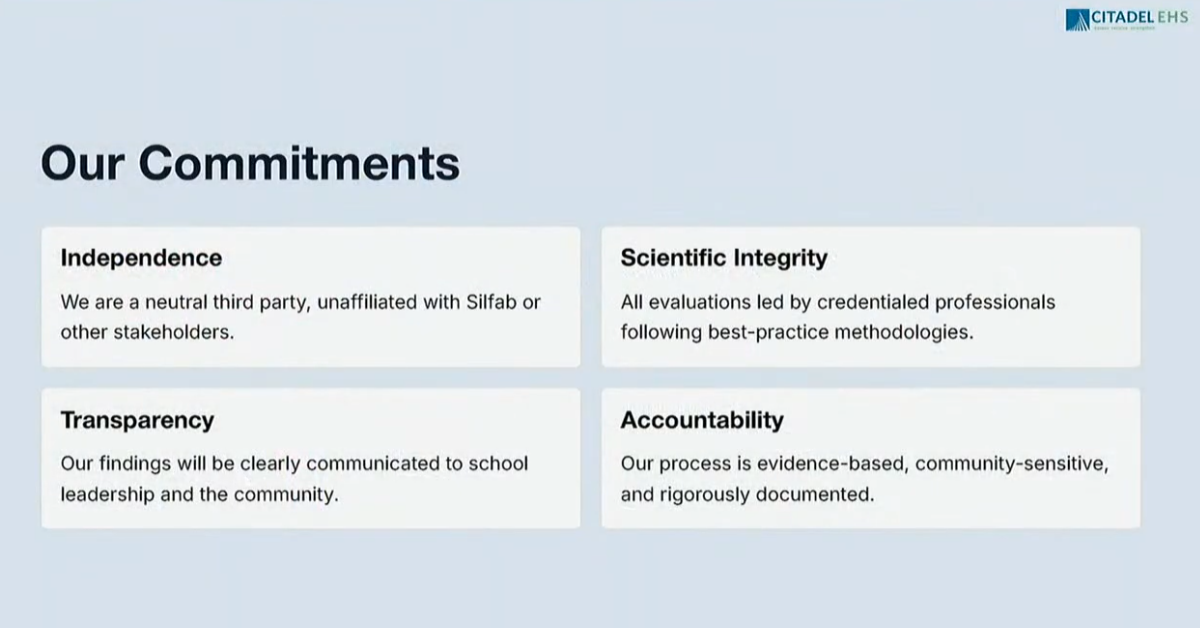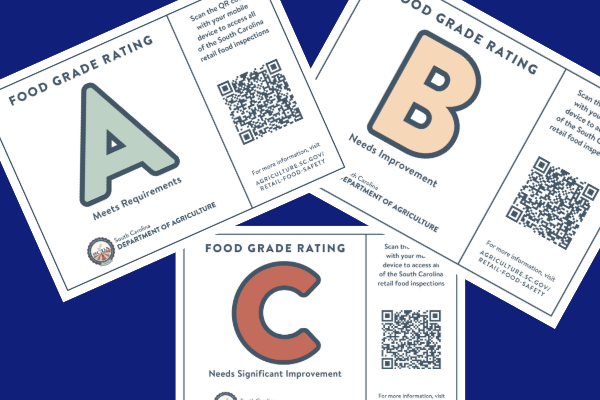FORT MILL, S.C. — The Fort Mill School District has taken formal steps to address environmental health and safety concerns tied to the proximity of the Silfab Solar manufacturing facility to Flint Hill Elementary and Middle Schools. In response to recommendations from the Pediatric Environmental Health Specialty Units (PEHSU) and growing public concern, the district has contracted with Citadel Environmental Health & Safety (EHS) to conduct a comprehensive, independent assessment.
During a recent Fort Mill School Board meeting, Joe Burke introduced the initiative, noting that it follows several months of work to identify a qualified, independent firm. Julie Wojnowski, a Fort Mill resident and senior consultant with Citadel EHS, presented the firm’s scope of work and shared her personal commitment to the community.
Citadel’s Role and Methodology
Wojnowski emphasized Citadel EHS’s independence from both Silfab Solar and the school district, underscoring the firm’s reputation for scientific integrity and transparency. “Our job is to perform an in-depth, transparent evaluation examining both emissions and the school’s internal systems so this community can move forward with facts, clarity, and trust,” she said.
Key components of the assessment include:
- Review of External Emissions Risk:
Citadel is analyzing Silfab Solar’s air permits, safety data sheets (SDS), emissions modeling, and emergency protocols. The focus is on identifying risks from chemicals and industrial processes, including potential fire or explosion hazards. - Internal School Safety Assessment:
District HVAC systems, ventilation design, filtration standards, and emergency preparedness plans are being reviewed in detail. This includes real-time evaluation of air circulation rates and equipment capability. - Baseline and Ongoing Monitoring:
Wojnowski explained that a baseline assessment—conducted before building occupancy—will help differentiate environmental conditions with and without student and staff presence. Air and possibly water samples will be analyzed for pollutants such as volatile organic compounds (VOCs) and particulate matter (PM), both common in industrial emissions. - Well Health-Safety Rating Pursuit:
The district is aiming to achieve the WELL Health-Safety Rating, a third-party certification recognizing best practices in air and water quality, sanitation, and emergency preparedness. All documentation for this rating will be prepared in time for the schools’ opening. - Community Engagement and Transparency:
Citadel has pledged to hold regular briefings, including public sessions and updates to staff and families. Wojnowski expressed openness to reviewing community-submitted reports and studies and said Citadel would consider them alongside publicly available data and official permits.
Site Collaboration and Future Monitoring
Citadel is in communication with Silfab Solar and plans to tour the facility. While this is not a formal inspection, it allows consultants to view containment structures and chemical storage areas. These insights will support Citadel’s recommendation for potential air quality triggers or student evacuation protocols if emissions exceed safe levels.
“The goal is a monitoring plan aligned with EPA and industry standards that can guide the district in real-time,” Wojnowski explained. For example, if Silfab is required to monitor emissions inside containment areas, the district may mirror that with nearby ambient air monitoring to ensure student safety.
Citadel’s team includes certified industrial hygienists, safety professionals, and environmental compliance experts with experience in complex environments, such as refinery conversions and post-disaster school reopenings. Case studies shared during the meeting included lead-in-water testing in Los Angeles and air quality remediation after wildfires in California.
Citadel’s Experience and Qualifications
Citadel EHS brings over 30 years of experience in environmental health and safety consulting. The firm is 100% employee-owned and staffed by certified industrial hygienists, engineers, scientists, and environmental compliance specialists.
Its portfolio includes major projects with public schools and universities, such as:
-
Los Angeles Unified School District (LAUSD): Over two decades of partnership involving lead, asbestos, and air quality monitoring.
-
University of California, Los Angeles (UCLA): More than 2,000 indoor air quality and hazardous material safety projects.
-
California Institute of Technology (Caltech): Real-time air monitoring to prevent contamination from lab exhausts.
Citadel has also led post-disaster assessments, including wildfire-related air quality testing at Palisades Charter High School, and coordinated the safe reopening of a 2,500-student campus within 30 days.
Their industrial oversight work spans refinery conversions, biofuels projects, and fire risk assessments for pharmaceutical facilities. Each project, according to Wojnowski, demonstrates Citadel’s ability to deliver technical expertise in high-stakes, community-sensitive environments.
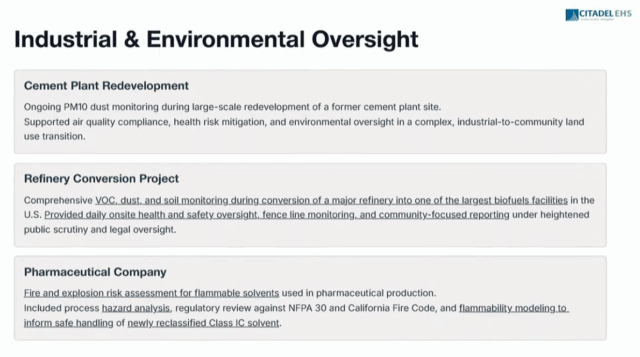
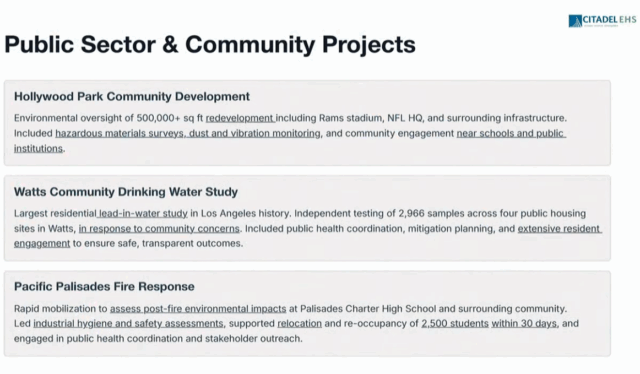
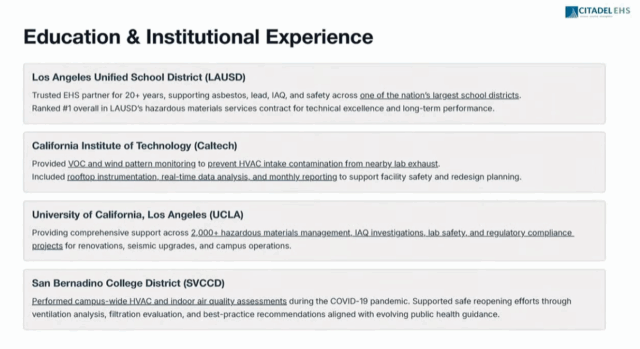
Next Steps and Timeline
Citadel expects to deliver a preliminary action plan to district leadership in the coming weeks. Final implementation steps—including any air quality sampling—will proceed based on those recommendations and in alignment with school opening schedules.
“This is just the first phase,” Wojnowski noted. “We hope this is a long-term engagement that includes ongoing updates, community education, and adaptive strategies as conditions evolve.”
Board members expressed appreciation for Citadel’s approach and emphasized the importance of transparency and responsiveness to public concern.
More updates will be provided by the district over the summer as the assessment progresses and as Flint Hill Elementary and Middle Schools prepare to open.
Sign up for our Sunday Spectator. Delivered to your inbox every Sunday, with all the news from the week.










